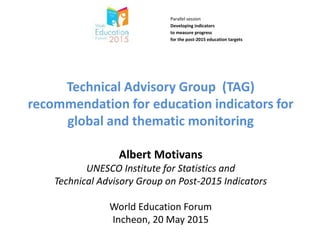Technical Advisory Group (TAG) recommendation for education
- 1. ŌĆ” Technical Advisory Group (TAG) recommendation for education indicators for global and thematic monitoring Albert Motivans UNESCO Institute for Statistics and Technical Advisory Group on Post-2015 Indicators World Education Forum Incheon, 20 May 2015 Parallel session Developing indicators to measure progress for the post-2015 education targets 14:30-16:00 Wednesday, 20 May 2015
- 2. The scope of the education targets in the SDGs 0-5 6-14 15-24 25+ Ages Target 4.7 Target 4.6 Target 4.4 Target 4.3Target 4.2 Target 4.1 Target 4.5 equityCross-cutting Means of implementation Targets 4.8, 4.9, 4.10
- 3. Proposed levels of monitoring (UNSG*) *UN Secretary GeneralŌĆÖs Synthesis Report, December 2014 National Link to national plan; consult national stake- holders; recognise context and address inclusion and broader learning goals Global Focused set of globally comparable indicators based on clear criteria (10-15 indicators) Thematic Broader set of indicators covers the range of sectoral priorities (42 indicators) Regional Indicators to monitor frameworks validated by regional groupings (AU Education decades, EU2020)
- 4. Strong focus on quality and equity themes reflected in the global indicators ŌĆó Quality ŌĆō Should focus on small set of outcomes measures ŌĆō Should have direct measures of learning and skills ŌĆō Other quality measures also considered important ŌĆó Equity ŌĆō Disaggregate indicators where possible, strengthening messages on gender equity ŌĆō Ensure that multiple disadvantage is captured ŌĆō Ensure that disadvantaged groups and contexts difficult to measure receive special attention
- 5. Indicator proposals for global targets on basic education and literacy ŌĆó Percentage of children who achieve minimum proficiency standards in reading and mathematics at end of: (i) primary (ii) lower secondary ŌĆó Percentage of youth/adults proficient in literacy and numeracy skills ŌĆó Parity indices (female/male, urban/rural, bottom/top wealth quintile] for all indicators that can be disaggregated Key criteria Relevance: reflect the most critical policy themes in the targets Alignment: construct to be measured must be valid and reliable and have the same meaning in all settings. Comparability: data are collected on a regular basis. Communicability: indicator easily understood and allows a clear narrative regarding progress towards the targets
- 6. Global monitoring challenges ŌĆó Early childhood research-based measures move to field- tested consensus on comparable indicators collected in a cost- effective way ŌĆó For learning outcomes at different ages/grades, efforts are underway to develop an approach to equate and link key national definitions of learning outcomes to compare results. ŌĆó For the measurement of literacy and numeracy by level of proficiency it will be critical to build on recent efforts to assess skills based on cost-effective approaches ŌĆó The core of the new agenda is related to equity. Need to measure and monitor differences in learning achievement across population groups.
- 7. National monitoring challenges ŌĆó Documented standards and definitions ŌĆó Measurement tools, metric, background data collection instruments ŌĆó Technical expertise and capacity for the collection and use of data ŌĆó Ensure impact on policy ŌĆō data that make a difference
- 8. Next steps ŌĆō the TAG and on-going UN processes related to indicators Education community ŌĆó Extended TAG, including Member States, to build consensus and improve framework (June-October) ŌĆó High-level UNESCO meeting of Ministers to adopt the education agenda and framework (November) UN processes ŌĆó First meeting of the Inter-Agency and Expert Group on SDG Indicators (June) ŌĆó Inter-governmental meeting on goals and targets (June-July) ŌĆó UN General Assembly meets to adopt targets (September) ŌĆó 47th UN Statistical Commission to consider the new indicator framework (March 2016) ŌĆó Framework submitted to ECOSOC for final adoption (July 2016)
- 9. Questions for discussion ŌĆó What are the strengths and weaknesses of the proposed thematic monitoring framework for the post- 2015 education goals? ŌĆó What will be issues in implementing the framework, such as capacity needs? ŌĆó What is still missing from the proposed thematic monitoring framework? ŌĆó What needs to happen next to formulate an overarching roadmap for measurement and monitoring?
Editor's Notes
- #5: many respondents highlighted the importance of equity and inclusion in the post-2015 agenda and the need to develop better methods for capturing all population groups, including people with disabilities and those affected by conflict or natural disasters. Some respondents commented on the importance of capturing the ŌĆ£systemŌĆØ of education, meaning inputs and processes, whereas others sought a singular focus on the direct measurement of learning. Indicators of quality in learning environments were highlighted as being especially important and yet lacking in availability
- #6: The TAG envisions global tracking as one part of a broader and more contextually-sensitive monitoring system that will be designed by countries and regions as part of their implementation of the Framework for Action. It is important to note that it is not possible to fully measure the breadth and vision behind the proposed goal and targets with available indicators. Therefore, the TAG has proposed an initial set of indicators based on their importance and feasibility with the understanding that this is considered to be an intermediate step towards a more complete data and measurement agenda for education, which will require further coordination and extensive investment to achieve.




![Indicator proposals for global targets on
basic education and literacy
ŌĆó Percentage of children who achieve
minimum proficiency standards in
reading and mathematics at end of: (i)
primary (ii) lower secondary
ŌĆó Percentage of youth/adults proficient
in literacy and numeracy skills
ŌĆó Parity indices (female/male,
urban/rural, bottom/top wealth
quintile] for all indicators that can be
disaggregated
Key criteria
Relevance: reflect the most
critical policy themes in the
targets
Alignment: construct to be
measured must be valid and
reliable and have the same
meaning in all settings.
Comparability: data are
collected on a regular basis.
Communicability: indicator
easily understood and allows
a clear narrative regarding
progress towards the targets](https://image.slidesharecdn.com/wefkoreamotivans15sepvv-150915154154-lva1-app6891/85/Technical-Advisory-Group-TAG-recommendation-for-education-5-320.jpg)



